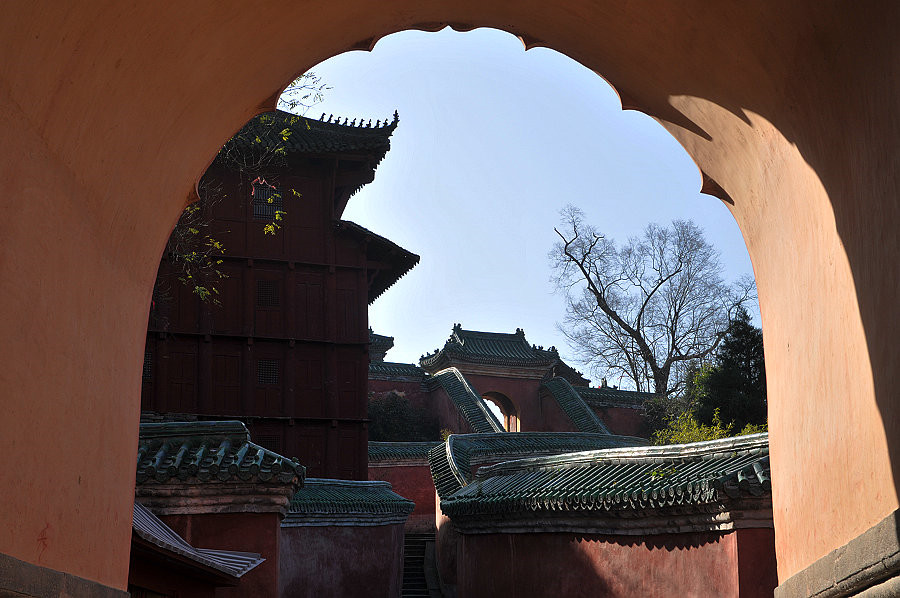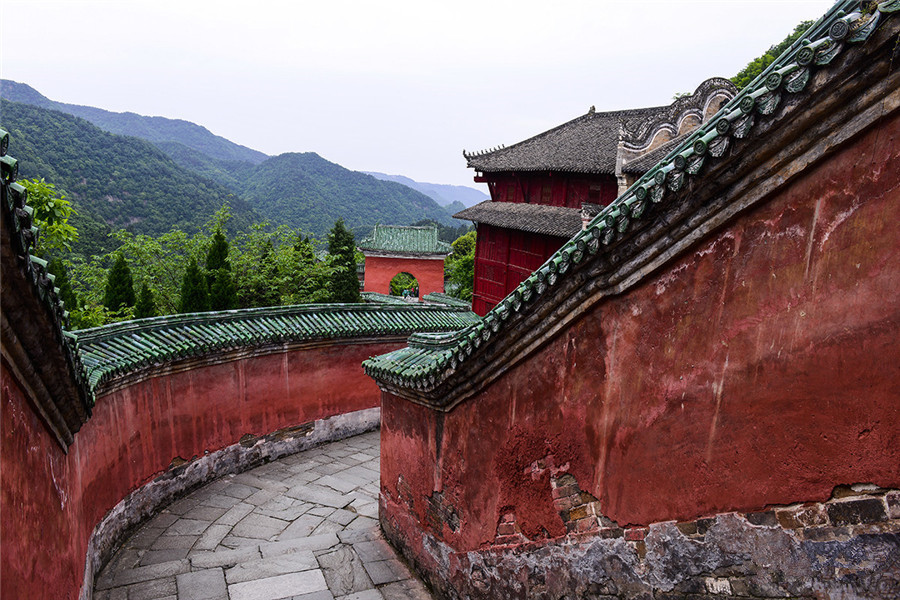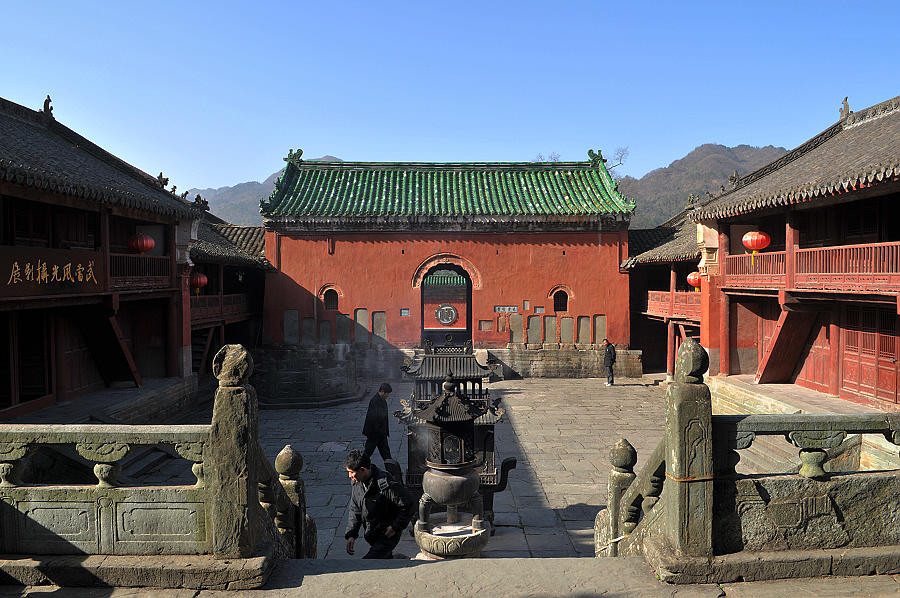
Prince Slope (Fuzhenguan) in Mount Wudang

Attractions Overview
According to the view of restoration, this ancient building on the 60-degree steep slope of Shizi Peak in Wudang Mountain has been praised by modern architects as a classic work of building on steep slopes.
Chinese Name: 复真观(太子坡)
English Name: Prince Slope (Fuzhenguan) in Mount Wudang
Type: Wuhan Scenic Area, Wuhan famous spots & Artificial attractions
Best Time: All Year Around
Recommended Visiting Hours: 2-3 hours
Opening Hours:08:00~17:00
Location: Wudang Mountain Tourism Special Economic Zone in Shiyan City, Hubei Province
Prince Slope, also known as Fuzhenguan (复真观), is a famous Taoist temple located on the steep Lion Peak (狮子峰) of Mount Wudang (武当山) in Hubei Province (湖北省), China. The temple is celebrated for its architectural brilliance, particularly its adaptation to the challenging mountainous terrain. Built on a 60-degree slope, the design of the temple makes it an iconic example of how ancient architects maximized the natural landscape to create harmony between nature and architecture.
The temple is surrounded by natural beauty, with Tianchi Waterfall (天池飞瀑) on one side and the Eighteen Steps Trail (十八盘栈道) winding up to the temple complex. Its unique location provides breathtaking views, earning it a place among the most significant cultural and historical sites in China.
The temple complex spans an area of 16,000 square meters and includes more than 200 rooms, along with notable architectural features such as the “One Li Four Gates” (一里四道门), “Nine Curves Yellow River Wall” (九曲黄河墙), and the “One Pillar Twelve Beams” (一柱十二梁). The temple’s cultural heritage and historical significance make it a must-visit for those interested in Chinese architecture and Taoist traditions.
Location
-
City: Danjiangkou (丹江口), Shiyan City (十堰市), Hubei Province (湖北省), China
-
Geological Area: Wudang Mountain National Geopark (武当山国家地质公园)
-
Scenic Area: Prince Slope Scenic Area (太子坡景区)
-
Opening Hours: Daily from 07:30 AM to 05:30 PM
-
Ticket Price: Free
-
Best Visiting Seasons: March to May (for blossoming flowers) and September to November (for misty mountain views)
-
Recommended Visit Duration: 1-2 hours
History and Development
The history of Fuzhenguan dates back to the Ming Dynasty (明朝). In the 10th year of the Yongle Emperor’s reign (永乐帝) in 1412, the emperor, Zhu Di (明成祖朱棣), commissioned the construction of the Xuandi Hall (玄帝殿) and other buildings within the complex. By the 32nd year of the Jiajing Emperor’s reign (嘉靖帝), the temple had expanded significantly, with over 200 buildings in total.
In the Qing Dynasty (清朝), several repairs were undertaken, most notably during the reign of Emperor Kangxi (康熙帝). However, over time, the temple fell into disrepair due to neglect. In 1982, the government funded a major restoration project, which successfully returned the temple to its original grandeur. Today, it is a protected cultural heritage site, open to visitors from around the world.
Famous Attractions
Nine Curves Yellow River Wall
One of the most striking features of Fuzhenguan is the Nine Curves Yellow River Wall (九曲黄河墙). This 71-meter-long wall, built into the natural terrain of the mountain, is designed to mimic the undulating curves of the Yellow River (黄河). The wall not only adds to the beauty of the temple but also represents a significant architectural achievement in utilizing the natural landscape to create functional structures. The Nine Curves Yellow River Wall is particularly revered for its symbolic connection to Taoist philosophy and is seen as a manifestation of the flowing energy of nature.
The wall is made of red brick and features green-glazed tiles at the top, forming a design reminiscent of two dragons soaring through the sky. The structure’s smooth curves and powerful presence are awe-inspiring and contribute to the temple’s mystique.
Fuzhenguan Main Hall
The Main Hall (大殿) is the focal point of the Fuzhenguan complex and is dedicated to the True Martial God (真武神). The hall, also known as the Master’s Hall (祖师殿), was originally built in the 10th year of the Yongle Emperor’s reign (永乐帝) and later expanded in the Jiajing Era (嘉靖帝). It was severely damaged during the Ming Dynasty but was rebuilt during the Qing Dynasty (清朝) under the Kangxi Emperor (康熙帝).
The Main Hall is known for its grand scale and is surrounded by other significant buildings, such as the Dragon and Tiger Hall (龙虎殿) and Nine Curves Yellow River Wall. The hall houses a large True Martial God statue, as well as attendants, and is one of the most impressive religious sites on Mount Wudang. The hall’s architectural style incorporates both Ming and Qing elements, making it a valuable example of the evolution of Chinese temple architecture.
Five Clouds Tower
The Five Clouds Tower (五云楼) is one of the tallest wooden structures on Mount Wudang, standing at a height of 15.8 meters. This architectural wonder was built without altering the natural shape of the mountain, demonstrating the ingenuity of ancient builders in adapting to the environment. The tower’s design is based on traditional building techniques, and its use of wooden beams and pillars enhances its connection with nature.
What makes the Five Clouds Tower particularly famous is the “One Pillar Twelve Beams” (一柱十二梁), an architectural feat in which twelve beams are intricately supported by a single central pillar. This structure is regarded as one of the finest examples of ancient Chinese wooden architecture and has been celebrated for its craftsmanship.
Taoist Cultural Significance
Prince Reading Hall
The Prince Reading Hall (太子读书殿) is dedicated to the young True Martial Emperor (真武帝), a central figure in Taoist mythology. The hall is designed to depict his early years of study and spiritual growth, with murals, ancient books, and artifacts such as ink brushes and stone tables. The hall symbolizes the importance of knowledge and perseverance in Taoist practice and is believed to bring blessings to those who visit.
It is said that students who visit the Prince Reading Hall will be inspired to focus on their studies and achieve success. This belief has made the hall a popular destination for students and their families, especially those seeking blessings for academic success.

Natural Scenic Beauty
The Prince Slope Scenic Area (太子坡景区) is not just a religious site, but also a place of stunning natural beauty. Visitors can enjoy panoramic views of Mount Wudang and its surrounding valleys, where lush forests and clear streams create a peaceful atmosphere. The Tianchi Waterfall (天池飞瀑) and the Eighteen Steps Trail (十八盘栈道) are just some of the natural attractions that complement the architectural marvels of Fuzhenguan.
In the evening, visitors can watch the iconic Wudang Mountain Sunset (武当山日落) from the highest point of the temple complex, where the setting sun casts a magical glow over the mountain peaks.
Practical Information
-
Transportation: The scenic area is easily accessible by car from Danjiangkou (丹江口) or Shiyan (十堰). Public transportation is also available from nearby towns and cities, with regular bus services to the main entrance.
-
Nearby Attractions: Visitors to Prince Slope can explore other famous Taoist temples and scenic spots in Mount Wudang, a UNESCO World Heritage site and a center of Taoist culture. Notable nearby attractions include the Purple Cloud Temple (紫云观) and Golden Peak (金顶).
Prince Slope (复真观) offers a unique experience for those interested in Taoist philosophy, ancient Chinese architecture, and the natural beauty of Mount Wudang (武当山). The site’s rich history and stunning surroundings make it an unforgettable stop for travelers seeking spiritual enlightenment and a deeper understanding of Taoism.

Main Attractions of Prince Slope
The ancient building complex in Prince Slope was designed according to the story of Zhenwu cultivation. The ancient building masters skillfully used the mountain terrain to build a wall like undulating waves, known as the Jiuqu Yellow River Wall. Entering Erdaoshan Gate, a broad courtyard suddenly appeared. Walking in, I saw the small courtyard overlapping, quiet and elegant. The overall layout of Prince Slope was uneven, scattered, coordinated and perfect, clever and mysterious. Place oneself in the highest place of the view of restoration of truth, looking down at the deep ravines and streams flowing green; Looking at the mountains, thousands of peaks show up.
The main attractions of this scenic spot include the exquisitely carved well pavilion of the needle grinding well, the Paleozoic marine invertebrate “right angle stone” and the murals of “Zhenwu Xiuzhen”. It is like 18 sets of ancient paths with colorful ribbons fluttering up and down, various strange rocks in Jiudu ravine, jade virtual rocks with steep risks and unique features, and so on.
Best Time to Travel Prince Slope
The best time to pay a visit is in March to May & September to November.
Wuhan has a monsoon (humid) climate in the northern subtropics, which is characterized by abundant rainfall, sufficient heat, the same season of rain and heat, the same season of light and heat, the same season of winter and Leng Xia heat, and distinct seasons. In spring, there is a temple fair on the 3rd of March in the Chinese lunar calendar, which is a good opportunity to experience the local culture. In autumn, Wudang International Tourism Festival is the best time to learn Wudang traditional culture.

How to Get There
- By train: from Beijing, Shanghai, Chongqing, Guangzhou, Nanjing, Qingdao, Wuhan or some other cities by train, get off at Wudang mountain station. Change to No.202 or 203 intercity bus and go directly to the scenic spot.
- Take a bus:
1. Starting from Shiyan: No.202 intercity bus can take tourists from Shiyan Railway Station to the mountain in 70 minutes.
2. From Xi ‘an: There are three direct tour buses to the scenic spot every day. It takes about 4 hours for a coach to leave Xi ‘an coach station opposite Xi ‘an railway station. the fare is CNY 111.5 yuan. The other two long-distance buses depart from coach station at Sanfu bay at 8:00 and 13:00 respectively, which takes about 4.5 hours and costs CNY 159 yuan. They all reached coach station 400 meters (440 yards) west of the entrance to Wudang mountain.
3. Starting from Wuhan: There is a through bus at Jinjiadun bus station, which starts at 13:40 every day. It takes about 6 hours and costs 179 yuan per person
- Flying: Tourists can fly from Xi ‘an, Tianjin, Kunming, Wuhan and Hangzhou to Wudang Mountain Airport. Then take a taxi to reach the mountain at a cost of 60-80 yuan RMB.
Useful Travel Tips
| Ticket Price | Entrance ticket: CNY 130; valid for 3 days Sigtseeing bus fee: CNY 100 Golden Palace: CNY 27 Grand Purple Cloud Palace: CNY 15 Note: 1. Visitors need to pay extra CNY 5 for insurance. 2. Visitors can take the sightseeing bus unlimitedly with a valid ticket. |
| Cable Car | Feb. 1 – Oct. 31: Up: CNY 90; Down: CNY 80 Nov. 1 – Next Jan. 31: Up: CNY 70; Down: CNY 60 |
| Opening Hours | 08:00 – 17:00 |












